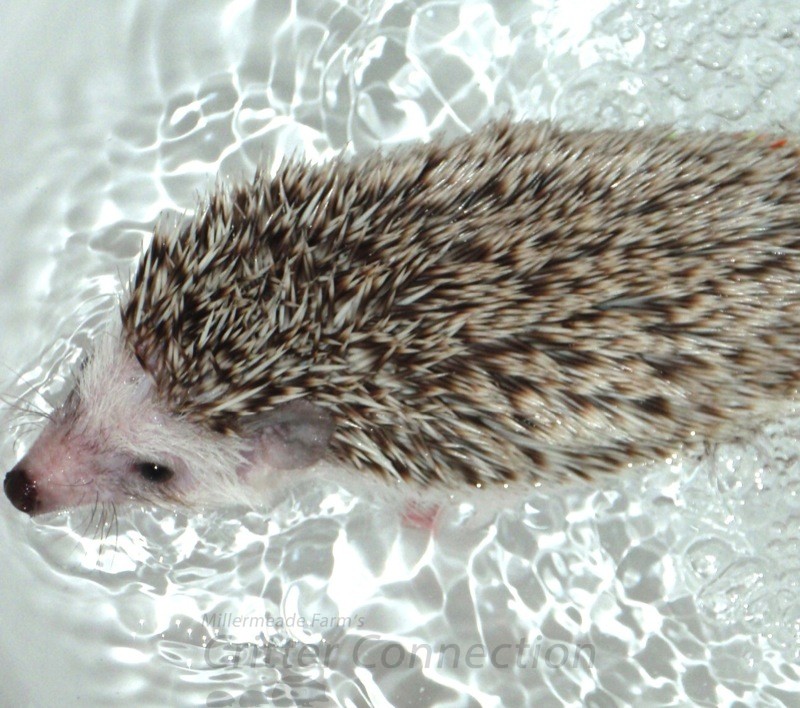Last Updated on October 19, 2022.

Hedgehogs and Bathing
- Many hedgehogs love to play in warm water and will enjoy themselves during bath time.
- Other hedgehogs may not like the water at all, but bathing a dirty hedgehog is necessary for the overall wellbeing of the animal.
- Some hedgehog owners have found giving hedgehogs a bath when they are young makes bathing less stressful when they are older.
- Even though hedgehogs are good swimmers, one should never leave a hedgehog unattended while in the water.
Frequency
- Hedgehogs do not groom or clean themselves like most other animals.
- You will know your hedgehog is ready for a bath when it looks dirty, has dry skin, “poop boots” (dirty feet from, well, you know!), or anointed spots of dried “stuff”.
- Once a month bathing is adequate for the average hedgehog.
- Some hedgehogs need baths frequently and others seldom need one.
- Bathing generally helps to relieve dry skin; however, bathing too frequently may contribute to dry skin.
Video.: How often
Suitable Bath Tubs
- Common places to give hedgehogs a bath are in a sink, dishpan, infant bathtub, laundry sink, or a bathtub.
- Hedgehogs are prone to relieve themselves in the warm water so it is a good idea to select a place that is easy to disinfect and that does not come in contact with food.
- Some owners prefer to have a dishpan or tub that is used only for hedgehog bathing.
- Infant bathtubs usually have drains that are handy for draining dirty water.
What You Will Need
- Make sure to gather all your needed supplies before you start. You will need soap or shampoo, a soft toothbrush, nail clippers, and a towel. Bath time is generally an ideal time to trim your hedgehog’s nails, especially if you are dealing with a hedgehog that does not cooperate during nail trims.
- A piece of indoor-outdoor carpet in the bottom of the sink makes the sink less slippery for your hedgehog and it helps clean the hedgehog’s feet and nails.
- A non-slip bathtub mat may also be helpful.
VIDEO.: Types of hedgehog brushes
Preparing the Water
- The temperature of the water should be warm, similar to what is comfortable for a human baby.
- Many water safety devices are on the market for checking water temperature. This type of product can be found in the infant or bathing section of stores.
- We recommend using one to three inches of water in the sink or bathtub. Some hedgehogs like to swim in a little deeper water and others are more comfortable walking around in more shallow water.
- Some people like to make sudsy water to wash their hedgehogs, but we prefer plain water since there is a chance the hedgehog could take a drink of the water or get water in its nose or mouth, even with the most careful bathing practices.
Bath Products
- Some veterinarians recommend only water, but most hedgehog owners use some type of bath product to help clean and soften the skin.
- Always watch the skin for signs of irritation to bath products.
- You can make homemade oatmeal soaks by placing a handful of oatmeal in a cheesecloth, baby washcloth, Bounty paper towel, or panty hose and hold it under the warm, running water. Squeeze the oatmeal to release the milky-colored emollients into the water. Oatmeal soaks are great for dry, itchy, or irritated skin for both hedgehogs and humans! You can purchase our Moisturizing Bath Soaks that are made with a soothing lavender and infused with our NIKS skin oil.
- Even though many shampoos might be considered “safe” for hedgehogs, keep in mind most shampoos can actually be very drying to the skin.
- Bathing is a popular topic on hedgehog internet lists. Some suggestions I have read on the lists are chamomile, oatmeal, or lavender soaps found at the health food store.
VIDEO.: Safe Soaps for Hedgehogs
More on Oils
The following information was posted by Teresa Johnson on Hedgehog_help yahoo group on Wednesday, June 20, 2001 in a discussion about “How often to bathe”. Thank you Teresa for these wonderful tips and advice!
- Please be very careful using Avon’s Skin So Soft – many folks also use this to repel mosquitoes, I’ve used it around doors and windows to repel ants from coming into the house, and it burns my skin terribly to use in a bath. As it is oil, it won’t wash off so simply should your hedgehog be sensitive to it. SSS also has chemical ingredients for fragrance and such that are not necessary for a hedgehog.
- Oils that are safe on hedgehog and other pet’s delicate skins include a tiny bit of olive oil, calendula oil, or lavender oil blended well into the final rinse water.
- Oils to avoid totally are: any mints including pennyroyal, eucalyptus, camphor, cinnamon, and clove. These are “hot” penetration oils/fragrances and can cause a chemical burn on tender skin, even on humans!!
Technique
- It is fairly normal for hedgehogs to poop, pee, and fidget in a bath until they get used to the idea.
- It is easier to wash a relaxed hedgehog, so you may want to give your hedgehog a little time to get used to the water and relax its spines.
- Lathering a little soap in your hands then rubbing it on your hedgehog tends to be easier than applying the soap directly to your pet.
- Use a soft bristle brush or an old toothbrush on the hedgehog’s spines and feet.
- Carefully rinse all the soap from your hedgehog. This is very important because soap residue can cause dry skin or more severe irritations.
Video.: cleaning brushes
Purchase brushes here: BRUSHES
Safety
- Avoid getting water in the hedgehog’s eyes, ears, nose and mouth.
- No human or animal likes soap in his or her eyes, but in the event of an accident, tear-free baby shampoo is unlikely to cause harm.
- Hedgehogs that are not familiar with bathing or a swim could unintentionally aspirate water up their nose, which can certainly cause larger problems down the road.
- It is also important to keep ears as dry as possible and to dry them as good as possible after the bath. A warm, moist environment such as ears is a perfect place for fungus to grow.
Drying Your Hedgehog
- Wrap your hedgehog up in a hand towel to soak up most of the wetness. Switch to another dry hand towel to help dry your hedgehog a little faster.
- Microfiber and micro-fleece towels work well to absorb moisture as well.
- Be sure to watch toenails so that they don’t get caught in the looped threads of most towels.
- For special hedgehog luxury, you can use machine or hair dryer warmed towels.
- Some people prefer to heat the towel with a hair dryer while the hedgehog is wrapped up inside. This is only safe if you are holding your hedgehog in your hand in the towel. It is very easy to burn your hedgehog with a hair dryer. Never use the dryer directly on your hedgehog even on a low setting.
- It is important to make sure the hedgehog is completely dry after its bath to prevent chilling.
Skin Care
- It is an opportune time to help condition your hedgehog’s skin after you have cleaned and dried your hedgehog.
- Millermeade Farms has been using olive oil directly on the skin of hedgehogs to help relieve dry skin and relieve itching for many years.
- Healthy skin helps maintain a tight barrier that creates an inhospitable environment for mites and thus is a natural mite preventive.
Observing Feet and Legs
- While daily observation of your pet is important, bath time may provide an occasion when you may have better lighting and a more cooperative pet.
- It is important to carefully observe your hedgehog’s feet and legs. Loose threads from a variety of sources, such as human hair and carpet fibers, can wrap around a hedgehog’s feet. The extent of the resulting damage can range from mild discomfort to loss of blood supply to the foot and subsequent need for amputation.
- Refer to our Signs of Good Health guide for more detailed information on what else to look for when observing your pet.
Foot Baths
- Many hedgehogs need a footbath much more frequently than a whole body bath.
- When hedgehogs eliminate while using their wheel, their feet can become caked with feces.
- A piece of indoor-outdoor carpet in the bottom of the sink makes the sink less slippery for your hedgehog and it helps clean the hedgehog’s feet and nails.
- Sometimes simply allowing your hedgehog to walk around in warm, shallow water on indoor/outdoor carpet will soften feces enough that feet can be easily rubbed clean before being handled.
- Be sure to wash or replace soiled carpet so as not to create a literal germ factory that could cause more harm than good.
- Hedgehogs that are comfortable standing up in a sink without a mat can have their feet scrubbed with a toothbrush, after soiled feet are soaked and the crud is softened.
Nail Trimming
- Many hedgehog owners have found that the best time to trim nails is after a bath.
- The nails are clean and slightly softened from the bath.
- Hedgehogs are often more relaxed and tolerate nail trimming after a bath.
- See our Nail Trimming article for more details.
Contributors: Gail Smith, Melissa Ramos






